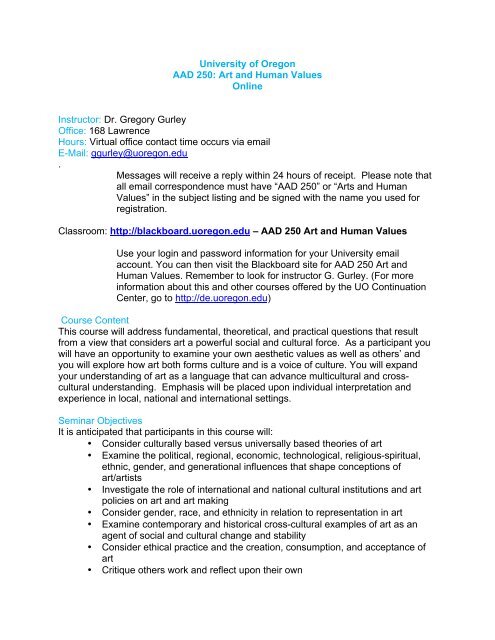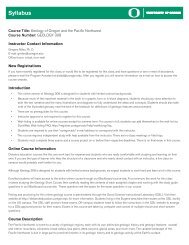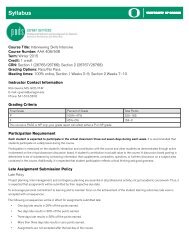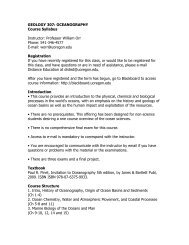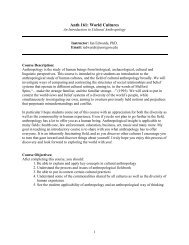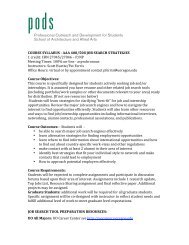Course Syllabus - University of Oregon
Course Syllabus - University of Oregon
Course Syllabus - University of Oregon
Create successful ePaper yourself
Turn your PDF publications into a flip-book with our unique Google optimized e-Paper software.
<strong>University</strong> <strong>of</strong> <strong>Oregon</strong>AAD 250: Art and Human ValuesOnlineInstructor: Dr. Gregory GurleyOffice: 168 LawrenceHours: Virtual <strong>of</strong>fice contact time occurs via emailE-Mail: ggurley@uoregon.edu.Messages will receive a reply within 24 hours <strong>of</strong> receipt. Please note thatall email correspondence must have “AAD 250” or “Arts and HumanValues” in the subject listing and be signed with the name you used forregistration.Classroom: http://blackboard.uoregon.edu – AAD 250 Art and Human ValuesUse your login and password information for your <strong>University</strong> emailaccount. You can then visit the Blackboard site for AAD 250 Art andHuman Values. Remember to look for instructor G. Gurley. (For moreinformation about this and other courses <strong>of</strong>fered by the UO ContinuationCenter, go to http://de.uoregon.edu)<strong>Course</strong> ContentThis course will address fundamental, theoretical, and practical questions that resultfrom a view that considers art a powerful social and cultural force. As a participant youwill have an opportunity to examine your own aesthetic values as well as others’ andyou will explore how art both forms culture and is a voice <strong>of</strong> culture. You will expandyour understanding <strong>of</strong> art as a language that can advance multicultural and crossculturalunderstanding. Emphasis will be placed upon individual interpretation andexperience in local, national and international settings.Seminar ObjectivesIt is anticipated that participants in this course will:• Consider culturally based versus universally based theories <strong>of</strong> art• Examine the political, regional, economic, technological, religious-spiritual,ethnic, gender, and generational influences that shape conceptions <strong>of</strong>art/artists• Investigate the role <strong>of</strong> international and national cultural institutions and artpolicies on art and art making• Consider gender, race, and ethnicity in relation to representation in art• Examine contemporary and historical cross-cultural examples <strong>of</strong> art as anagent <strong>of</strong> social and cultural change and stability• Consider ethical practice and the creation, consumption, and acceptance <strong>of</strong>art• Critique others work and reflect upon their own
TextThe text for this class is available at the Bookstore and via <strong>University</strong> Readers, Inc.To purchase your textbook online, please follow the instructions below:Step 1: Log on to https://students.universityreaders.com/store/ .Step 2: Create an account or log in if you have an existing account to purchase.Step 3: Easy-to-follow instructions will guide you through the rest <strong>of</strong> the orderingprocess.<strong>Course</strong>: ART & HUMAN VALUESINSTRUCTOR: GREG GURLEYI will post some additional readings and websites on Blackboard to frame our weeklylectures, activities and presentations. There will be self-selected readings for your termresearch paper.Class RequirementsThis class requires: graded written work; evaluation <strong>of</strong> your own and other’s work;presentation <strong>of</strong> projects; group work and discussions, as well as assigned reading; all <strong>of</strong>which will require working outside <strong>of</strong> allotted class time. You must have access to acomputer and a connection to Blackboard for this class.Evaluation and GradingThis course uses a cumulative point system; all assignments and projects have a pointvalue that is totaled for your final course grade. You will also be graded on writtenanalyses and reflective questioning. You will be graded upon your participation andyour willingness to complete all assigned tasks on time.Academic HonestyPlagiarism is a serious <strong>of</strong>fense. The consequences for using the words <strong>of</strong> anotherwithout quotation marks or citation, or <strong>of</strong> using the ideas and conclusions <strong>of</strong> anotherwithout citation, are severe. In this course, such academic dishonesty will not betolerated. For further information regarding academic dishonesty, seehttp://libweb.uoregon.edu/guides/plagiarism/students/Be aware that if I find evidence <strong>of</strong> plagiarism, cheating, or other incidents <strong>of</strong> academicdishonesty the <strong>of</strong>fense will be dealt with as per the Student Conduct Code rules, whichcan be found at: http://studentlife.uoregon.edu/programs/student_judi_affairs/conductcode.htmWhy you should cite sources (list compiled by L. Ettinger, 2003):• To demonstrate your knowledge <strong>of</strong> the work <strong>of</strong> others• To build upon the ideas <strong>of</strong> others, thus extending knowledge• To allow others to analyze your work in relation to a larger body <strong>of</strong> material• To document your theoretical and practical perspectives• To define your context and terms• To join a learning community
Use <strong>of</strong> ImagesImages posted are available for use in this format under an educational fair use policy.This policy requires that they be used for educational purposes only. Therefore, toprotect images from copyright infringement, students should not download or alterimages in any way.School <strong>of</strong> Architecture and Allied Arts descriptionThe School <strong>of</strong> Architecture and Allied Arts is dedicated to advancing the understanding,value, and quality <strong>of</strong> visual culture and the built, natural, and social environmentsthrough excellent and distinctive teaching, research, and creative endeavors. Groundedin a unique multi-disciplinary structure, AAA is a diverse, collegial learning community <strong>of</strong>faculty, students, and staff. We seek to enhance the lives <strong>of</strong> individuals andcommunities through endeavors that stem from intellectual curiosity, critical thinking,and broad inquiry, rooted in the inter-relatedness <strong>of</strong> theory, history, and practice. Insupport <strong>of</strong> this mission, AAA affirms the following values:• Excellence -- supporting and celebrating a culture that promotes rigor,encourages risk-taking, and challenges standards in creating, composing, andpresenting ideas.• Open discourse -- Fostering the open exchange and critique <strong>of</strong> ideas in anenvironment that welcomes a diversity <strong>of</strong> views.• Inclusiveness -- Actively encouraging the presence and participation in theSchool <strong>of</strong> individuals with differing backgrounds, experience, and world-views.• Cooperation -- Working together in shared efforts to teach, learn, understand,and create.• Inter-disciplinary Experience -- Engaging multiple disciplines to expand ourperspective and enrich our teaching, research, and creative practice.• Responsibility -- Recognizing our accountability for the impact <strong>of</strong> our actions onenvironmental, social, and cultural


